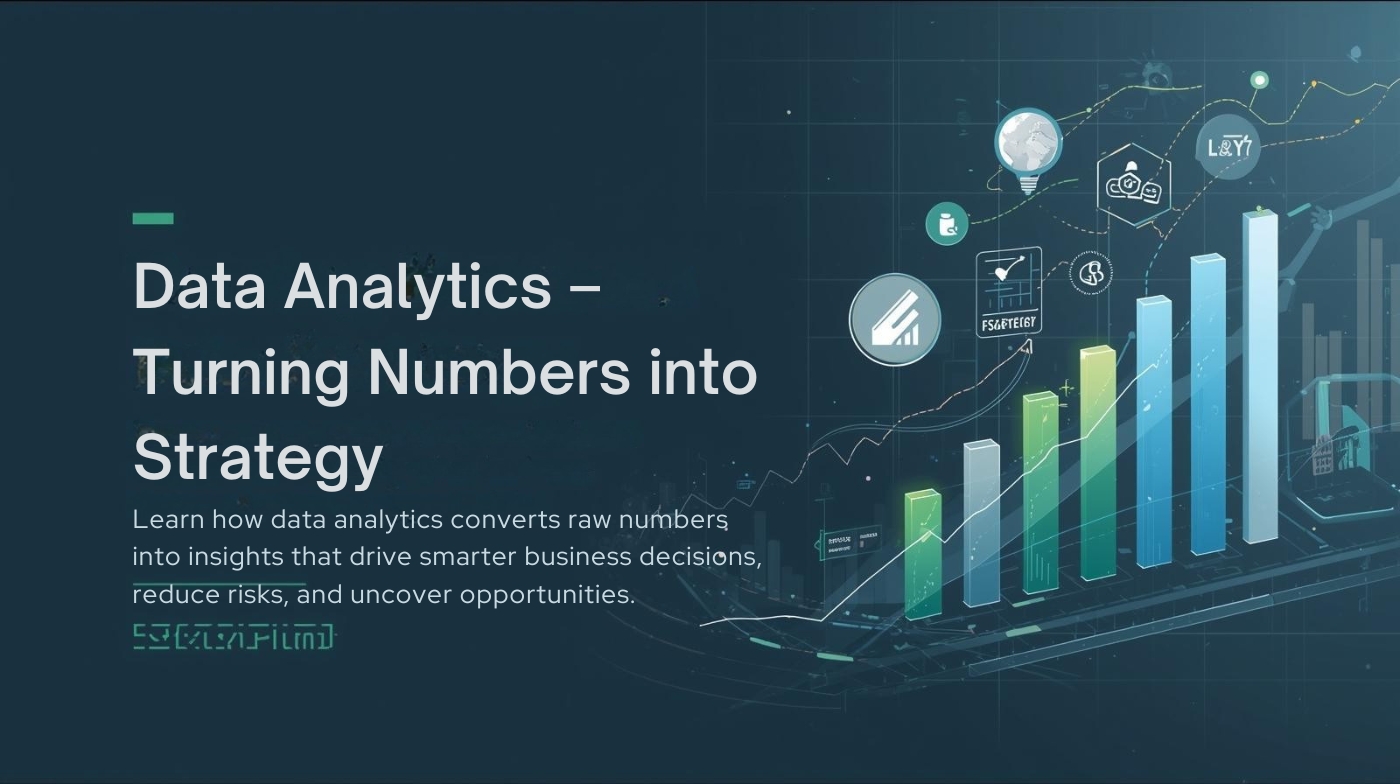Data Analytics – Turning Numbers into Strategy

Introduction
We live in a data-driven world. Every click, purchase, and online interaction generates data. But raw numbers alone are meaningless without interpretation. That’s where data analytics comes in. It transforms scattered datasets into stories, insights, and strategies that empower businesses and individuals to make better decisions.
Data analytics is no longer a luxury for large corporations—it’s a necessity for every organization that wants to survive and thrive in the modern digital economy. In this blog, we’ll explore what data analytics is, why it’s so powerful, how it works, and how businesses of all sizes can harness it for growth.
What is Data Analytics?
At its core, data analytics is the process of examining datasets to draw conclusions. It’s about converting raw numbers into actionable intelligence. Data analytics can be descriptive (what happened), diagnostic (why it happened), predictive (what might happen), or prescriptive (what should be done).
- Descriptive Analytics: Summarizes historical data (e.g., last quarter’s sales).
- Diagnostic Analytics: Explains causes (e.g., why sales dropped).
- Predictive Analytics: Forecasts future outcomes using statistical models and machine learning.
- Prescriptive Analytics: Suggests actions to achieve optimal results (e.g., how to increase customer retention).
Why Data Analytics Matters
- Smarter Decision-Making: Leaders can base choices on evidence, not intuition.
- Competitive Advantage: Businesses that embrace analytics understand markets better and move faster.
- Risk Reduction: Analytics highlights potential threats before they escalate.
- Efficiency Gains: Data shows where resources are wasted and how to optimize operations.
- Customer Understanding: Analytics reveals preferences, behaviors, and pain points.
How Data Analytics Works – The Process
- Data Collection: Gathering data from various sources (CRM systems, website traffic, social media, IoT devices).
- Data Cleaning: Removing errors, duplicates, and inconsistencies.
- Data Storage: Using databases or cloud warehouses to structure the data.
- Data Analysis: Applying statistical models, algorithms, and visualization techniques.
- Interpretation: Translating findings into actionable business strategies.
Real-World Examples of Data Analytics in Action
- Netflix: Uses viewing data to recommend content and decide what shows to produce.
- Amazon: Predicts customer preferences and personalizes shopping experiences.
- Healthcare: Hospitals analyze patient records to detect patterns and improve treatments.
- Sports: Teams use player performance data to shape strategies and prevent injuries.
- Banking: Analytics helps detect fraud and improve credit risk assessments.
Case Study: Starbucks and Data Analytics
Starbucks doesn’t just serve coffee—it serves personalized experiences powered by analytics. Through its loyalty program and mobile app, Starbucks collects millions of data points daily: customer purchase habits, favorite drinks, and peak ordering times. They analyze this data to tailor promotions, recommend items, and even decide on new store locations. The result? Increased sales, customer loyalty, and a data-driven competitive edge.
Tools and Technologies for Data Analytics
- Software Platforms: Power BI, Tableau, Google Analytics.
- Programming Languages: Python, R, SQL.
- Big Data Frameworks: Hadoop, Spark.
- AI and Machine Learning: Automating predictive and prescriptive analytics.
- Visualization Tools: Graphs, heatmaps, dashboards for easier interpretation.
The Role of Predictive Analytics
Predictive analytics is a game-changer. By analyzing historical data, businesses can forecast future events. For instance:
- Retailers predict demand for seasonal products.
- Airlines forecast passenger traffic and adjust pricing.
- Banks assess creditworthiness before issuing loans.
The real value lies in anticipating problems before they occur and seizing opportunities before competitors do.
Challenges in Data Analytics
- Data Quality: Inaccurate or incomplete data leads to wrong conclusions.
- Privacy Concerns: Collecting personal data raises ethical and legal issues.
- Data Overload: Too much data without clear goals can overwhelm decision-makers.
- Skilled Talent Shortage: Data scientists and analysts are in high demand.
- Integration: Combining data from multiple sources can be technically complex.
Best Practices for Effective Data Analytics
- Define Clear Objectives: Know what questions you’re trying to answer.
- Invest in Data Quality: Clean, accurate data is the foundation of analytics.
- Visualize Results: Dashboards and charts make data easier to digest.
- Combine Human and Machine Insights: Algorithms are powerful, but human judgment ensures relevance.
- Stay Ethical: Respect privacy laws like GDPR and maintain transparency.
The Future of Data Analytics
As AI and machine learning continue to evolve, data analytics will become even more predictive and prescriptive. Real-time analytics will dominate, with businesses making instant decisions based on live data. Self-service analytics platforms will empower non-technical professionals to explore and visualize data without coding. The next wave will be augmented analytics—AI assisting humans in every step of the process.
FAQs on Data Analytics
Q1: What skills are needed for a career in data analytics?
Knowledge of statistics, data visualization, programming (Python, R), SQL, and business acumen.
Q2: Can small businesses benefit from data analytics?
Absolutely. Even small businesses can analyze customer feedback, sales data, and website traffic to make smarter decisions.
Q3: Is data analytics expensive to implement?
Not necessarily. With cloud platforms and open-source tools, analytics has become accessible and cost-effective.
Conclusion
Data analytics is the bridge between raw numbers and meaningful action. Businesses that fail to adopt it risk being left behind in today’s competitive landscape. From predicting customer needs to optimizing operations, analytics is the secret ingredient for sustainable growth. But remember: the technology is only as good as the strategy behind it. By defining clear goals, investing in data quality, and balancing machine intelligence with human expertise, organizations can turn analytics into a true competitive advantage.
The future belongs to those who don’t just collect data, but who know how to use it to write the story of their success.







